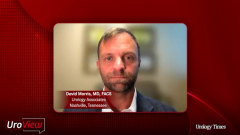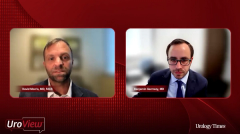
Enhancing Efficacy in Advanced Hormone-Sensitive Prostate Cancer Treatment
Join key opinion leaders as they analyze the evolving landscape of metastatic HSPC, delving into the advantages and key factors to consider with triplet combination therapies, encompassing chemotherapy and ARPI agents.
Episodes in this series

Transcript:
David Morris, MD, FACS: Some of the biggest changes probably for what we’ve been doing in terms of therapies have been in the metastatic hormone-sensitive or castration-sensitive advanced prostate cancer patients. That’s where most of the growth in the last few years has been with combination therapies. I do think the NCCN [National Comprehensive Cancer Network] guidelines changes over the last couple of years have really mirrored all the trials that have been published and presented.
It’s moved combination therapy earlier and earlier. As I explained to patients 20 years ago, monotherapy ADT [androgen deprivation therapy] was the standard. Very quickly, that moved to ADT plus chemotherapy because some of our best trials early were combinations with chemotherapy. Then right behind it came the combination trials of ARPIs [androgen receptor pathway inhibitors] and also abiraterone in addition to some of the AR agents. Now every combination therapy basically has NCCN support for doublet treatment. But with that ease of access to combinations with ARPI agents has been the decline in the use of chemotherapy, which is still a good therapy at the right time and the right patients.
The next phase beyond that is if 2 things are good, are 3 things better? The clinical trials quickly recognize, well, if docetaxel works, and if an ARPI works, what about if we combine the 2? We have different mechanisms of action on top of the ADT. There have been a couple of trials that have looked at that triplet therapy, PEACE-1 and ARASENS, with recent publications looking at rigorous combination triplet therapy. Then there was a subset out of the ENZAMET study, which was enzalutamide, where patients had had concurrent chemotherapy. There are data on safety, there are data on outcomes. I think that the PEACE-1 and ARASENS have really shown us there’s a patient population that probably benefits.
If you’re going to give docetaxel with ADT, you should intensify on top of it with an additional AR agent. I think that is the crux of our relationship is trying to find out which are the right patients that need both of us so that I can see them start ADT, discuss the therapy plan, start an ARPI agent, and have them see Dr Garmezy to have a conversation about docetaxel addition. That’s really, I think, why this group dynamic and this shared decision-making between our multidisciplinary clinic has really thrived. It’s a subset of patients, maybe not for everyone, but for the ones who potentially have benefit, I think we’re getting chemotherapy to them earlier when they can handle it better. It does open the door downstream for if they don’t have a prolonged response, the highest-risk men are very likely to need a second- or third-line therapy that we have different open doors to us if they’ve already had chemotherapy delivered to them.
Dr Garmezy, I just wanted to get your thoughts on the first-line triplet combinations in terms of, how difficult is that to manage? From a medical oncologist’s viewpoint, it’s not challenging at all, but to hear it from the urologist who’s going to be referring, we almost have to make a sales pitch sometimes to the patients about the tolerability of adding something else in that we’re not comfortable with.
Benjamin Garmezy, MD: I think that’s key here. Cancer, chemotherapy, 2 charged C-words, right? For a lot of people, unfortunately, cancer is all too common; 1 in 2 or 1 in 3 people in America are going to get diagnosed with cancer. A lot of us have familiarity with, say, a breast cancer chemotherapy regimen or some other chemotherapy regimen, which is much more intense than single-agent docetaxel, which was used in these trials. Either with the enzalutamide data set, the abiraterone data set, or the darolutamide data set, they’re all using docetaxel because that’s going back to before we were using a ton of ARPIs, we were intensifying with 6 cycles of docetaxel in the metastatic hormone-sensitive disease state.
We knew that by doing that, patients were going to have delayed time of castration resistance, right? Now, the thought is what we haven’t done in those data sets is compared the triplet with chemotherapy to the doublet, not with chemotherapy, but with the ARPI. We haven’t done that, but we still think it provides benefit. The reason for that is we’re debulking these potential resistant clones that are eventually going to become castration resistant. When we get a referral over from urology to discuss chemotherapy, oftentimes they know what they’re coming to discuss, and that is helpful. But if they don’t know what they’re coming to discuss, the first thing I’ll do is try to explain that one, for the vast majority of men in this disease setting, this is not going to be a challenge. They’re going to sail through 6 cycles of therapy without many speed bumps. We’re going to check their labs all the time. We’re going to make sure they’re safe.
If we have to stop or pause, then we’ll stop or pause and just keep them on the doublet with the ARPI. But it is much easier to deliver the chemotherapy in this setting than in the CRPC [castration-resistant prostate cancer] setting. We know from these new data sets that those patients who get triplet therapy, again, not compared with a doublet with ARPI, but they do very, very well and have years before they become castration resistant, which allows them to go through maybe 3 months of what I call a headache or a speed bump or a bad dream, but eventually they’re getting back to their routine, their normal lives, so that they can do that for a longer amount of time before we again see another inflection point where they’re going to need more aggressive therapies.
Transcript is AI-generated and edited for readability.
Newsletter
Stay current with the latest urology news and practice-changing insights — sign up now for the essential updates every urologist needs.























